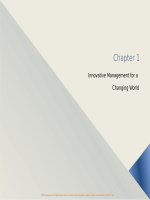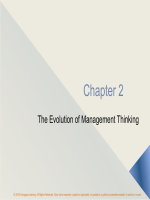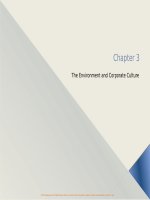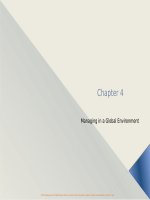Management 12e by w griffin ch03
Bạn đang xem bản rút gọn của tài liệu. Xem và tải ngay bản đầy đủ của tài liệu tại đây (1.86 MB, 32 trang )
TWELFTH EDITION
MANAGEMENT
Ricky W. Griffin
Part Two: Understanding the
Environmental Context of Management
Chapter Three: Understanding
the Organization’s Environment
© 2017 Cengage Learning. All rights reserved. May not be copied, scanned, or duplicated, in whole or in part, except for use as permitted
in a license distributed with a certain product or service or otherwise on a password-protected website for classroom use.
3-1
Learning Outcomes
1. Discuss the nature of the organizational
environment and identify the environments of
interest to most organizations.
2. Describe the components of the general and
task environments and discuss their impact on
organizations.
3. Identify the components of the internal
environment and discuss their impact on
organizations.
© 2017 Cengage Learning. All rights reserved. May not be copied, scanned, or duplicated, in whole or in part, except for use as permitted
in a license distributed with a certain product or service or otherwise on a password-protected website for classroom use.
3-2
Learning Outcomes
4. Discuss the importance and determinants of an
organization’s culture and how the culture can
be managed.
5. Describe the multicultural environment of
business and identify major trends and
dimensions of diversity and multiculturalism.
6. Identify and describe how the environment
affects organizations and how organizations
adapt to their environment.
© 2017 Cengage Learning. All rights reserved. May not be copied, scanned, or duplicated, in whole or in part, except for use as permitted
in a license distributed with a certain product or service or otherwise on a password-protected website for classroom use.
3-3
Organization’s Environments
External
environment
Internal
environment
Everything
outside an
organization’s
boundaries that
might affect it.
The conditions
and forces
within an
organization.
© 2017 Cengage Learning. All rights reserved. May not be copied, scanned, or duplicated, in whole or in part, except for use as permitted
in a license distributed with a certain product or service or otherwise on a password-protected website for classroom use.
3-4
Figure 3.1
The Organization and Its Environments
There are actually
two separate external
environments: the
general environment
and the task
environment.
© 2017 Cengage Learning. All rights reserved. May not be copied, scanned, or duplicated, in whole or in part, except for use as permitted
in a license distributed with a certain product or service or otherwise on a password-protected website for classroom use.
3-5
External Environment
General
environment
Task
environment
The set of broad
dimensions and
forces in an
organization’s
surroundings that
create its overall
context.
Specific
organizations or
groups that
influence an
organization.
© 2017 Cengage Learning. All rights reserved. May not be copied, scanned, or duplicated, in whole or in part, except for use as permitted
in a license distributed with a certain product or service or otherwise on a password-protected website for classroom use.
3-6
Figure 3.2
McDonald’s General Environment
The general
environment of an
organization consists
of economic,
technological,
sociocultural,
political-legal, and
international
dimensions.
© 2017 Cengage Learning. All rights reserved. May not be copied, scanned, or duplicated, in whole or in part, except for use as permitted
in a license distributed with a certain product or service or otherwise on a password-protected website for classroom use.
3-7
The General Environment
Economic
dimension
Technological
dimension
Sociocultural
dimension
• The overall health and vitality of the economic
system in which the organization operates.
• The methods available for converting resources into
products or services.
• The customs, mores, values, and demographic
characteristics of society.
• The government regulation of business and the relationship
Political-legal
between business and government.
dimension
International
dimension
• The extent to which an organization is involved in or
affected by business in other countries.
© 2017 Cengage Learning. All rights reserved. May not be copied, scanned, or duplicated, in whole or in part, except for use as permitted
in a license distributed with a certain product or service or otherwise on a password-protected website for classroom use.
3-8
Figure 3.3
McDonald’s Task Environment
The task
environment
includes
competitors,
customers,
suppliers,
strategic partners,
and regulators.
© 2017 Cengage Learning. All rights reserved. May not be copied, scanned, or duplicated, in whole or in part, except for use as permitted
in a license distributed with a certain product or service or otherwise on a password-protected website for classroom use.
3-9
The Task Environment
Competitors
• An organization that competes with other organizations for
resources.
Customers
• Whoever pays money to acquire an organization’s
products/services.
Suppliers
• An organization that provides resources for other organizations.
Strategic partners (strategic allies)
• An organization working together with one or more other
organizations in a joint venture or similar arrangement.
© 2017 Cengage Learning. All rights reserved. May not be copied, scanned, or duplicated, in whole or in part, except for use as permitted
in a license distributed with a certain product or service or otherwise on a password-protected website for classroom use.
3 - 10
The Task Environment
Regulators
• A unit that has the potential to control, legislate, or
otherwise influence the organization’s policies and
practices.
Regulatory agencies
• An agency created by the government to regulate
business activities.
Interest group
• A group organized by its members to attempt to influence
business.
© 2017 Cengage Learning. All rights reserved. May not be copied, scanned, or duplicated, in whole or in part, except for use as permitted
in a license distributed with a certain product or service or otherwise on a password-protected website for classroom use.
3 - 11
Figure 3.1
The Organization and Its Environment
An organization’s
internal
environments consist
of their owners,
boards of directors,
employees, physical
work environments,
and cultures.
© 2017 Cengage Learning. All rights reserved. May not be copied, scanned, or duplicated, in whole or in part, except for use as permitted
in a license distributed with a certain product or service or otherwise on a password-protected website for classroom use.
3 - 12
The Internal Environment
Owners
• Whoever can claim property rights to an organization.
Board of directors
• Governing body elected by a corporation’s
stockholders and charged with overseeing the general
management of the firm to ensure that it is being run in
a way that best serves the stockholders’ interests.
© 2017 Cengage Learning. All rights reserved. May not be copied, scanned, or duplicated, in whole or in part, except for use as permitted
in a license distributed with a certain product or service or otherwise on a password-protected website for classroom use.
3 - 13
The Internal Environment
Employee issues include
– A workforce becoming increasingly diverse in
• gender, ethnicity, age, and other dimensions.
– Increased reliance on “temp” workers.
– Labor unions add a complex layer.
Physical work environment issues include
– location, design, and layout.
© 2017 Cengage Learning. All rights reserved. May not be copied, scanned, or duplicated, in whole or in part, except for use as permitted
in a license distributed with a certain product or service or otherwise on a password-protected website for classroom use.
3 - 14
The Organization’s Culture
Culture defies objective measurement or
observation yet is the foundation of the internal
environment.
Organization culture
The set of values, beliefs, behaviors, customs,
and attitudes that helps the members of the
organization understand what it stands for, how
it does things, and what it considers important.
© 2017 Cengage Learning. All rights reserved. May not be copied, scanned, or duplicated, in whole or in part, except for use as permitted
in a license distributed with a certain product or service or otherwise on a password-protected website for classroom use.
3 - 15
The Organization’s Culture
Importance of organizational culture
– It can shape the firm’s effectiveness and longterm success, and increase productivity.
Determinants of organizational culture
– Develops over a long period of time.
– Often starts with the founder.
– Includes such things as corporate success
and shared experiences.
© 2017 Cengage Learning. All rights reserved. May not be copied, scanned, or duplicated, in whole or in part, except for use as permitted
in a license distributed with a certain product or service or otherwise on a password-protected website for classroom use.
3 - 16
Managing Organization Culture
Managers must understand current culture.
If it is in the best interests of the firm,
– managers should reward behavior consistent
with the culture.
If current culture needs changing,
– mangers must identify the culture they prefer,
– bring in outsiders, adopt new slogans, and tell
new stories to support the new culture.
© 2017 Cengage Learning. All rights reserved. May not be copied, scanned, or duplicated, in whole or in part, except for use as permitted
in a license distributed with a certain product or service or otherwise on a password-protected website for classroom use.
3 - 17
The Multicultural Environment
• The broad issues associated
with differences in values,
beliefs, behaviors, customs,
and attitudes held by people in
different cultures.
• Exists in a group or
organization when its members
differ from one another along
one or more important
dimensions, such as age,
gender, or ethnicity.
Multiculturalism
Diversity
Organization culture, multiculturalism, and
diversity are closely related concepts.
© 2017 Cengage Learning. All rights reserved. May not be copied, scanned, or duplicated, in whole or in part, except for use as permitted
in a license distributed with a certain product or service or otherwise on a password-protected website for classroom use.
3 - 18
Figure 3.4
Reasons For Increasing Diversity and
Multiculturalism
The most fundamental trend is that all organizations
are becoming more diverse and multicultural.
© 2017 Cengage Learning. All rights reserved. May not be copied, scanned, or duplicated, in whole or in part, except for use as permitted
in a license distributed with a certain product or service or otherwise on a password-protected website for classroom use.
3 - 19
Dimensions of Diversity and
Multiculturalism
Average age is increasing.
Increasing numbers of females in workforce.
– Glass ceiling is a perceived barrier that keeps
women from advancing to top management.
Ethnicity
– the ethnic composition of a group or
organization, continues increasing.
© 2017 Cengage Learning. All rights reserved. May not be copied, scanned, or duplicated, in whole or in part, except for use as permitted
in a license distributed with a certain product or service or otherwise on a password-protected website for classroom use.
3 - 20
Figure 3.5
Ethnicity Distribution Trends in the U.S.
The greatest increase in
expected growth is within the
Hispanic population.
© 2017 Cengage Learning. All rights reserved. May not be copied, scanned, or duplicated, in whole or in part, except for use as permitted
in a license distributed with a certain product or service or otherwise on a password-protected website for classroom use.
3 - 21
Trends in Diversity and Multiculturalism
Other Diversity Dimensions
Physical mobility.
Religion.
Single parents.
Dual-career marriages.
Alternative lifestyles.
Vegetarianism.
Political ideologies.
Multicultural Differences
Some organizations
– actively enhance their
multiculturalism.
Soon, all companies may
become multicultural,
– due to changes in the
external labor market.
– U.S. immigration is at its
highest rate since 1910.
© 2017 Cengage Learning. All rights reserved. May not be copied, scanned, or duplicated, in whole or in part, except for use as permitted
in a license distributed with a certain product or service or otherwise on a password-protected website for classroom use.
3 - 22
Organization-Environment Relationships
Organizations are open systems and
interact with various dimensions in many
different ways.
First:
– how environments affect organizations.
Second:
– how organizations adapt to their environments.
© 2017 Cengage Learning. All rights reserved. May not be copied, scanned, or duplicated, in whole or in part, except for use as permitted
in a license distributed with a certain product or service or otherwise on a password-protected website for classroom use.
3 - 23
How Environments Affect Organizations
Three basic perspectives:
– environmental change and complexity,
– competitive forces, and
– environmental turbulence.
© 2017 Cengage Learning. All rights reserved. May not be copied, scanned, or duplicated, in whole or in part, except for use as permitted
in a license distributed with a certain product or service or otherwise on a password-protected website for classroom use.
3 - 24
Figure 3.6
Environmental Change, Complexity, and
Uncertainty
Degrees of
homogeneity
and change
combine to
create
uncertainty.
© 2017 Cengage Learning. All rights reserved. May not be copied, scanned, or duplicated, in whole or in part, except for use as permitted
in a license distributed with a certain product or service or otherwise on a password-protected website for classroom use.
3 - 25









